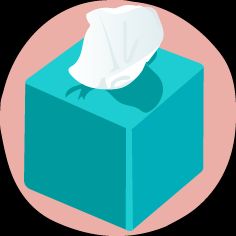Vaginal Lumps and Bumps: Causes Identification Treatment

Vaginal lumps and bumps are common and can be caused by many different conditions. You can manage most vaginal bumps and lumps at home. All
- Breast Cancer
- Cancer Care
- Caregiving for Alzheimer’s Disease
- Chronic Kidney Disease
- Chronic Obstructive Pulmonary Disease (COPD)
- Digestive Health
- Eye Health
- Heart Health
- Menopause
- Mental Health
- Migraine
- Multiple Sclerosis (MS)
- Parkinson’s Disease
- Psoriasis
- Rheumatoid Arthritis (RA)
- Sleep Health
- Type 2 Diabetes
- Weight Management
All- Controlling Ulcerative Colitis
 Navigating Life with Bipolar Disorder
Navigating Life with Bipolar Disorder- Mastering Geographic Atrophy
 Managing Type 2 Diabetes
Managing Type 2 Diabetes
All- CBD
- Fitness
- Healthy Aging
- Hearing
- Mental Well-Being
- Nutrition
- Parenthood
- Recipes
- Sexual Health
- Skin Care
- Sleep Health
- Vitamins and Supplements
- Women’s Wellness
All- At-Home Testing
- Men’s Health
- Mental Health
- Nutrition
- Sleep
- Vitamins and Supplements
- Women’s Health
All-  Your Guide to Glucose Health
Your Guide to Glucose Health
-
Inflammation and Aging
-
 Cold & Flu Season Survival Guide
Cold & Flu Season Survival Guide -
 She’s Good for Real
She’s Good for Real -
Video Series
-
Pill Identifier
-
FindCare
-
Drugs A-Z
All- Crohn’s and Ulcerative Colitis Essentials
- Diabetes Nutrition
- High Cholesterol
- Taming Inflammation in Psoriasis
- Taming Inflammation in Psoriatic Arthritis
All- Anxiety and Depression
-
Digestive Health
-
Heart Health
-
Migraine
-
Nutrition Edition
-
Type 2 Diabetes
-
Wellness Wire
-
Find a Diet
-
Find Healthy Snacks
-
Weight Management
-
How Well Do You Sleep?
-
Are You a Workaholic?
All- Can 6-6-6 Walking Workout Help You Lose Weight?
-
This Couple Lost 118 Pounds Together Without Medication
-
5 Science-Backed Ways to Live a Longer Life
-
Morning Coffee May Help You Live Longer
-
‘Weekend Warrior’ Workouts for Your 2025 Fitness Goals
-
5 Tips for a Healthy Lifestyle
-
How to Disinfect Your House After the Flu
-
Best Vegan and Plant-Based Meal Delivery for 2025
-
Does Medicare Cover Pneumonia Shots?
-
Chromosomes, Genetics, and Your Health
-
Best Multivitamins for Women
-
Best Multivitamins for Men
-
Best Online Therapy Services
-
Online Therapy That Takes Insurance
-
Buy Ozempic Online
-
Mounjaro Overview
-
Youth in Focus
-
Healthy Harvest
-
Through an Artist’s Eye
-
Future of Health
Bezzy communities provide meaningful connections with others living with chronic conditions. Join Bezzy on the web or mobile app.
All-  Breast Cancer
Breast Cancer
 Multiple Sclerosis
Multiple Sclerosis Depression
Depression Migraine
Migraine Type 2 Diabetes
Type 2 Diabetes Psoriasis
Psoriasis
Can’t get enough? Connect with us for all things health.
 Medically reviewed by Stacy A. Henigsman, DO — Written by Susan York Morris — Updated on April 11, 2024Lumps and bumps in and around the vagina are common. They can be harmless or a sign of an underlying condition that requires medical attention.
Medically reviewed by Stacy A. Henigsman, DO — Written by Susan York Morris — Updated on April 11, 2024Lumps and bumps in and around the vagina are common. They can be harmless or a sign of an underlying condition that requires medical attention.
If you’ve ever wondered about genital lumps, bumps, or discolored skin, you’re not alone. Keep reading to learn more about the causes of changes in this area and when to consult a healthcare professional.
Vagina vs. vulva
When people refer to the vagina, they’re often referring to both the internal organ (the vagina) and external genitalia, known as the vulva.
The term “vulva” encompasses the:
- clitoral hood
- clitoris glans
- inner labia
- outer labia
- vaginal vestibule, which is outside of the vaginal opening
The vagina is a muscular tube that leads to your cervix, which is the opening to your uterus.
The top layer of tissue in your vagina is mucous membrane, similar to tissue in your mouth or nose.
The bumps and ridges on the surface of your vagina are called rugae. They’re like folds or pleats of extra tissue when your vagina is relaxed. During sex or childbirth, rugae enable your vagina to expand.
The vulva includes several organs:
- Outer labia: These are the outer lips of your vulva. On the outer side, your pubic hair grows. The hairless skin of the inner fold is smoother and contains oil glands called sebaceous glands.
- Inner labia: If you gently open the outer labia, you’ll see your entire inner labia. These are the inner lips of thin skin surrounding the opening to your vagina.
- Skene’s glands and Bartholin’s glands: These glands produce mucus and other lubricants. They’re found on the inner labia, and the outer labia are also dotted with oil glands.
Causes of vaginal lumps and bumps
Here are 10 possible causes for changes to the skin of your vulva and vagina:
Vulvar cysts
Your vulva has many glands, including oil glands, Bartholin’s glands, and Skene’s glands. If these glands become clogged, a cyst can form.
Cysts vary in size, but most feel like small, hard lumps. They aren’t usually painful unless they become infected.
Cysts typically go away without treatment. If a cyst becomes infected, a doctor can drain it. If there are signs of infection, you may be prescribed antibiotics.
Vaginal cysts
There are several types of vaginal cysts. Vaginal cysts are firm lumps on the wall of the vagina. They’re usually about the size of a pea or smaller.
Vaginal inclusion cysts are the most common type of vaginal cyst. They sometimes form after childbirth or injury to the vagina.
Vaginal cysts usually aren’t painful. They’re rarely a cause for concern unless they cause discomfort during penetration. Occasionally, vaginal cysts need to be drained or removed surgically.
Fordyce spots
Fordyce spots, or sebaceous glands, are small white or yellow-white bumps inside the vulva. These spots can also be found on the lips and cheeks.
They normally first appear during puberty. You tend to get more of them as you age.
Fordyce spots are painless and not harmful.
Varicosities
Varicosities are swollen veins that can occur around your vulva. According to a 2017 study, they happen in up to 34% of people with varicose veins in the pelvis and up to 22% of pregnant people.
They appear as bluish raised bumps or round swollen veins around the labia. You may not experience pain, but sometimes they can feel heavy, cause itching, or bleed.
You may have discomfort with penetration or when standing for long periods. A doctor specializing in vein surgery and treatment can treat this condition.
But no treatment is usually needed if you’re pregnant. Varicosities usually recede about 6 weeks after childbirth. They do often reoccur with any subsequent pregnancies, though.
Ingrown hair
Shaving, waxing, or plucking pubic hair increases your risk of ingrown pubic hair.
Ingrown hair can cause a small, round, sometimes painful, itchy bump to form. The bump may be filled with pus, and the skin around it may also become darker.
In most cases, ingrown hairs resolve without treatment. But if inflammation develops, visit a doctor. It could be a sign of infection that needs treatment.
Skin tags
Skin tags, or polyps, are small, protruding flaps of extra skin. They don’t cause harm or discomfort unless they rub against something and become irritated.
If your skin tags are bothersome, a doctor can remove them surgically or with a laser.
Lichen sclerosus
Lichen sclerosus mainly occurs after menopause. It’s not a common skin condition.
Lichen sclerosus is most often seen on the vulva and around the anus. Symptoms may include:
- severe itching
- white or discolored spots
- skin that may tear easily
- bleeding or bruising
- pain when urinating or during penetration
Corticosteroid cream or ointment can typically treat lichen sclerosis. However, the condition may return after treatment. People with lichen sclerosus have a slightly increased risk of vulvar cancer.
Genital herpes
Genital herpes is an infection caused by the herpes simplex virus (HSV). HSV is transmitted through intimate skin-to-skin contact.
Often, the symptoms are so mild that many people with herpes aren’t aware they have the condition.
When an outbreak occurs, symptoms may include:
- blistery sores or ulcers that may ooze or bleed
- pain, itching, or tingling
- fever
- swollen glands
Herpes symptoms often clear up and then return. Over time, most people experience fewer and less severe outbreaks.
There’s currently no cure for genital herpes, but you can manage the severity and duration of symptoms with antiviral medications.
Genital warts
Genital warts are caused by infection with the human papillomavirus (HPV) and are transmitted through intimate skin-to-skin contact.
Many people have genital warts and don’t know it. If you have symptoms, they may include:
- clusters of small skin-colored bumps
- rough patches of closely spaced warts, sometimes described as resembling a cauliflower
- itching or burning
There’s currently no cure for genital warts, but a doctor can remove them by using a prescription cream, laser, or surgery.
Some types of HPV can increase your risk of cervical cancer. If you have genital warts, visit a healthcare professional for a Pap test to see what type of HPV caused the warts.
Cancer
Cancers of the vulva or vagina are rare. Symptoms of precancerous and cancerous vulvar and vaginal conditions may include:
- abnormal bleeding
- unusual discharge
- noticeable skin lumps
- pain during penetration
To diagnose vulvar and vaginal cancers, a doctor takes a tissue sample from lesions and examines it under a microscope.
When to consult a doctor or other healthcare professional
It’s always a good idea to visit a doctor if you notice any changes to your body, including a new lump that doesn’t go away after a few weeks.
Reach out to a doctor if you have pain or signs of infection, such as:
- discharge from the lump that contains pus or blood
- symptoms of a sexually transmitted infection (STI), such as itching, pain when peeing, or rash
If you don’t already have an OB-GYN, the Healthline FindCare tool can help you find one near you.
Treatment options for vaginal bumps and lumps
You can manage most vaginal bumps and lumps at home. Here’s what you can do to help relieve your symptoms:
- If you have cysts, take warm baths several times a day for a few days. The warm water may help the cysts drain.
- Soak in a sitz bath in the tub or on the toilet. If you can’t take several baths a day, this can also help soften cysts. You can buy a sitz bath over the counter at most pharmacies.
- Avoid wearing clothing that rubs and chafes your vulva.
- Wear underwear made of natural materials, such as cotton. Natural materials are breathable and can help keep your genitals cool and dry.
The bottom line
It’s unlikely that lumps on your vagina are cause for alarm. Most will go away on their own or can be treated at home.
If you have an STI or suspect you do, reach out to a healthcare professional for testing. Starting STI treatment early can reduce your risk of any complications.
How we reviewed this article:
SourcesHistoryHealthline has strict sourcing guidelines and relies on peer-reviewed studies, academic research institutions, and medical journals and associations. We only use quality, credible sources to ensure content accuracy and integrity. You can learn more about how we ensure our content is accurate and current by reading our editorial policy.- Gavrilov SG. (2017). Vulvar varicosities: Diagnosis, treatment, and prevention.https://www.ncbi.nlm.nih.gov/pmc/articles/PMC5500487/
- Genital herpes – CDC basic fact sheet. (2022).https://www.cdc.gov/std/herpes/stdfact-herpes.htm
- Genital warts. (2023).https://www.nhs.uk/conditions/genital-warts/
- Ingrown hairs. (2023).https://www.nhs.uk/conditions/ingrown-hairs/
- Kraus CN. (2022). Vulvar lichen sclerosus.https://jamanetwork.com/journals/jamadermatology/fullarticle/2793784
- Lee WA, et al. (2023). Bartholin gland cyst.https://www.ncbi.nlm.nih.gov/books/NBK532271/
- Lee Yj, et al. (2020). Vulval cysts.https://dermnetnz.org/topics/vulval-cysts
- Lichen sclerosus. (2021). https://www.nhs.uk/conditions/lichen-sclerosus/
- Poizeau F, et al. (2021). Vulvar fordyce adenitis: A cohort of 45 women. https://www.sciencedirect.com/science/article/abs/pii/S0151963821000399
- Sally R, et al. (2021). Benign “lumps and bumps” of the vulva: A review.https://www.ncbi.nlm.nih.gov/pmc/articles/PMC8484947/
- Skin tags. (2023).https://www.nhs.uk/conditions/skin-tags/
- Vaginal cancer. (n.d.).https://www.cancer.org/cancer/vaginal-cancer.html
Share this article
SourcesHistoryHealthline has strict sourcing guidelines and relies on peer-reviewed studies, academic research institutions, and medical journals and associations. We only use quality, credible sources to ensure content accuracy and integrity. You can learn more about how we ensure our content is accurate and current by reading our editorial policy.- Gavrilov SG. (2017). Vulvar varicosities: Diagnosis, treatment, and prevention.https://www.ncbi.nlm.nih.gov/pmc/articles/PMC5500487/
- Genital herpes – CDC basic fact sheet. (2022).https://www.cdc.gov/std/herpes/stdfact-herpes.htm
- Genital warts. (2023).https://www.nhs.uk/conditions/genital-warts/
- Ingrown hairs. (2023).https://www.nhs.uk/conditions/ingrown-hairs/
- Kraus CN. (2022). Vulvar lichen sclerosus.https://jamanetwork.com/journals/jamadermatology/fullarticle/2793784
- Lee WA, et al. (2023). Bartholin gland cyst.https://www.ncbi.nlm.nih.gov/books/NBK532271/
- Lee Yj, et al. (2020). Vulval cysts.https://dermnetnz.org/topics/vulval-cysts
- Lichen sclerosus. (2021). https://www.nhs.uk/conditions/lichen-sclerosus/
- Poizeau F, et al. (2021). Vulvar fordyce adenitis: A cohort of 45 women. https://www.sciencedirect.com/science/article/abs/pii/S0151963821000399
- Sally R, et al. (2021). Benign “lumps and bumps” of the vulva: A review.https://www.ncbi.nlm.nih.gov/pmc/articles/PMC8484947/
- Skin tags. (2023).https://www.nhs.uk/conditions/skin-tags/
- Vaginal cancer. (n.d.).https://www.cancer.org/cancer/vaginal-cancer.html
FAQ
How to use a PP pump?
Alternating between pumping and resting, most power pumpers power pump for one hour, once a day: pump for 20 minutes, rest for 10, then pump for 10, rest for 10, and finish with a 10-minute pump. It will take a few days before you notice a difference in your milk supply, so be patient.Aug 3, 2021
How to use a pump correctly?
Place the breast shield or funnel over your nipple, and switch the machine on. Start with a slow speed – or one that is comfortable for you. It may take a few minutes before your milk starts flowing, once it does you can increase the speed. Switch breasts when your milk starts slowing down.
How long does it take to use a pennis pump?
What are the benefits of using a penis pump? Penis pumps are effective at producing erections for the majority of users. The duration depends on the individual, but 30 minutes or so may be expected. The devices are generally safe and have none of the side effects that can accompany ED medications.Nov 2, 2024
What is a pump and what does it do?
What is a Pump? Pumps are mechanical devices that use energy to move fluids from one point to another. The main application of pumps is to move fluids, such as gasses, oils, and water. An impeller or propeller is a part of a pump that helps move fluids through the device.
Growdesire.com offers comprehensive guides and reviews on pussy pumps, including usage instructions, benefits, and top recommendations to enhance your intimate experiences.
This site only collects related articles. Viewing the original, please copy and open the following link:Vaginal Lumps and Bumps: Causes Identification Treatment











































































